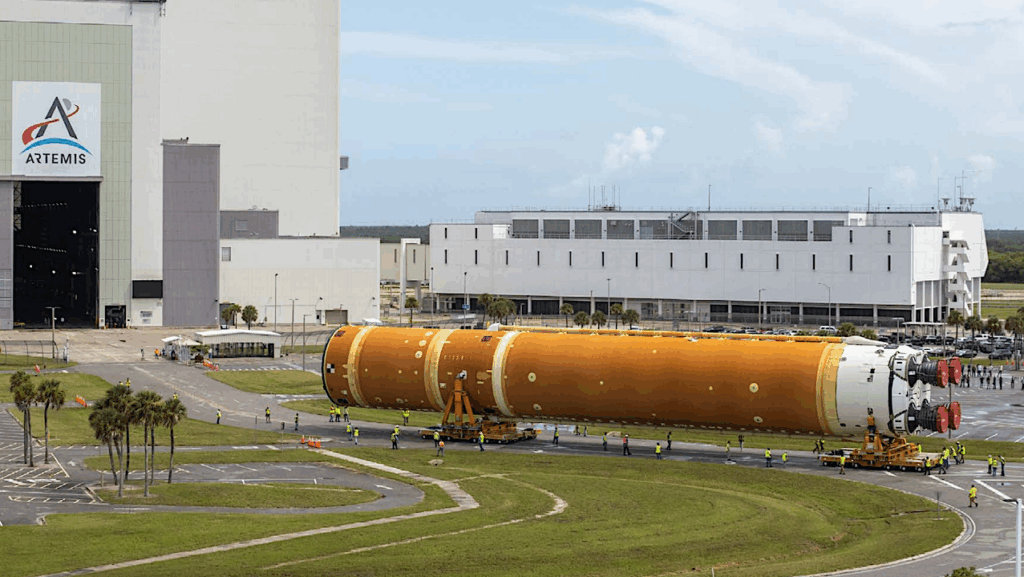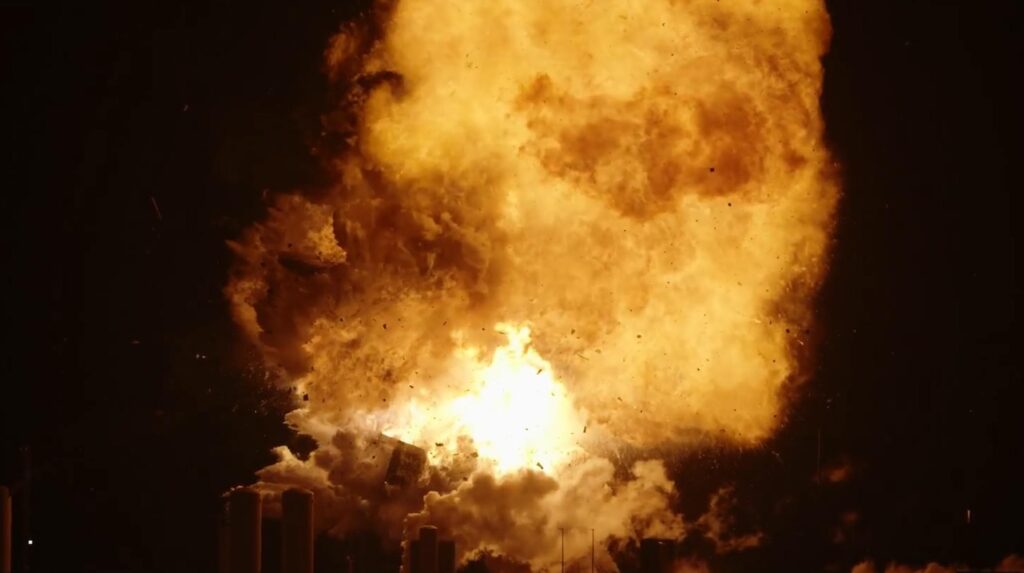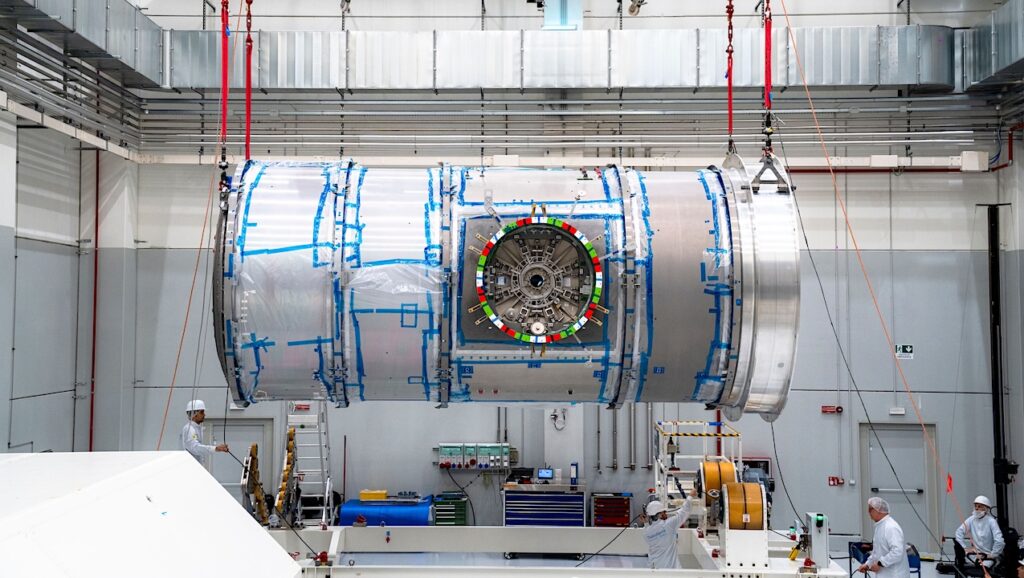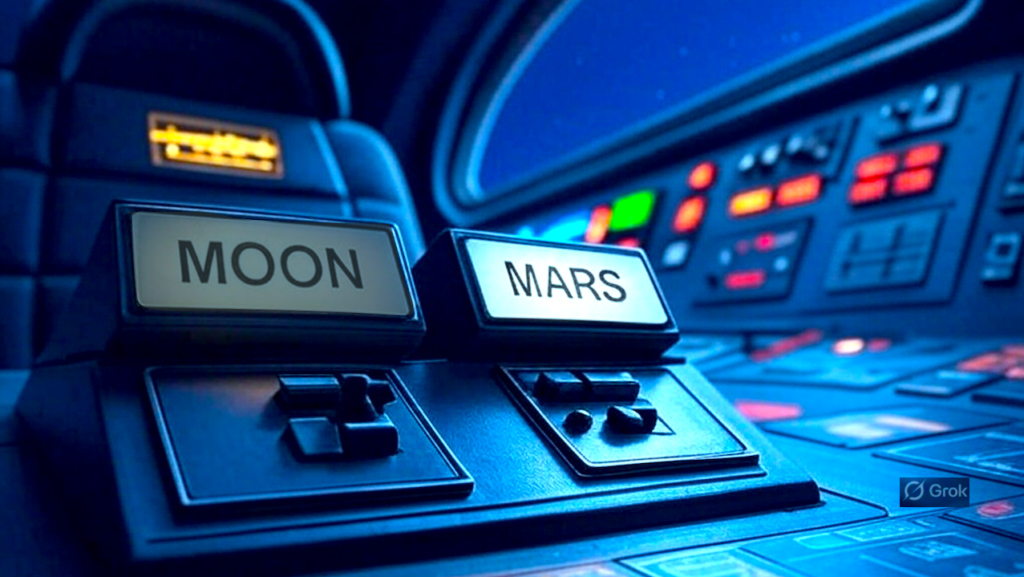NASA Signs Deal For Rockets It Does Not Have The Money To Pay For

NASA Commits to Future Artemis Missions With More SLS Rocket Stages
“For the first three Artemis missions, the SLS rocket uses an interim cryogenic propulsion stage to send the Orion spacecraft to the Moon. The SLS rocket is designed to meet a variety of mission needs by evolving to carry greater mass and volume with a more powerful EUS. The EUS is an important part of Artemis infrastructure needed to send astronauts and large cargo together, or larger cargo-only shipments, to the Moon, Mars and deep space. NASA aims to use the first EUS on the Artemis IV mission, and additional core stages and upper stages will support either crewed Artemis missions, science missions or cargo missions. “The exploration upper stage will truly open up the universe by providing even more lift capability to deep space,” said Julie Bassler, the SLS Stages manager at Marshall. “The exploration upper stage will provide the power to send more than 45 metric tons, or 99 thousand pounds, to lunar orbit.”
NASA will award Boeing a cost-plus contract for up to 10 SLS rockets, Ars Technica
“If it seems remarkable that a government contractor would get a cost-plus contract to produce a rocket that it has had nearly a decade to learn how to build, and which has moved into production, and which is based on heritage technology–that’s because it is. However, in their negotiations with NASA, companies like Boeing (and Lockheed Martin, which recently got a similar deal for the Orion spacecraft) know they have strong political backers. In the case of the SLS rocket, the Alabama delegation, which includes a Senator who effectively writes the agency’s budget, has made it clear that funding the SLS rocket is his priority. So in this case, while NASA may not have necessarily wanted to give Boeing a cost-plus contract for SLS rockets for the next 15 years, it may have had little choice.”
Aderholt says he hears from industry growing confidence could do 2 SLS cores per year beginning in 2024 and Block 1B in 2024. Agree?
Bridenstine and Bowersox both pour cold water on that.— Marcia Smith (@SpcPlcyOnline) October 16, 2019
 Keith’s note: One small problem. The money for EUS (or an accelerated Artemis for that matter) is not there despite the forward leaning language that NASA , Boeing, and the Alabama delegation like to use. Just sayin’ Indeed, if NASA had pushed the EUS earlier they could have avoided the whole Gateway thing. But NASA never does things logically.
Keith’s note: One small problem. The money for EUS (or an accelerated Artemis for that matter) is not there despite the forward leaning language that NASA , Boeing, and the Alabama delegation like to use. Just sayin’ Indeed, if NASA had pushed the EUS earlier they could have avoided the whole Gateway thing. But NASA never does things logically.
– GAO Anticipates First SLS Launch Date In 2021, earlier post
– Today’s Hearing on SLS, Orion, Artemis, earlier post
– NASA Admits That SLS Is A “Jobs Program”. Wow. Who Knew?, earlier post
– GAO: Human Space Exploration: Persistent Delays and Cost Growth Reinforce Concerns over Management of Programs, earlier post
– More SLS postings









So the money is not there, let alone there for “cost plus” contracts. Imagine where we would be if NASA and Congress were less corrupt and had funded Space X as planned.
How can NASA commit to this without the funding already approved?
What is the cost of this contract?
Taxpayers want to know.
No one knows what this will eventually costs. NASA has admitted that.
Might not cost anything! By the time they can get Congress to even think about funding such a contract, SpaceX will have landed on and established a lunar base, and will meet them in lunar orbit!
Government contracts will have a provision that they are subject to future appropriations; one Congress cannot appropriate funds in future Congresses.
So it’s a safe bet that before the SLS even gets off the ground the cost could exceed $50 billion at this rate.
Not sure that even with EUS you wouldn’t still need gateway given the undersized service module for Orion can’t really go anywhere else. With the ~21 day supply for food and life support the lander would have to augment the Orion shortfall. Plus Orion does not have the prop for a low lunar orbit mission unless again the lander has to be massive like Altair was growing to be but could even an EUS throw the bloated but under useful Orion plus an Altair to the Moon? The current architecture is full of bad decisions, crappy performance and hamstrung mission design with it all falling now to HLS to come up with a crafty solution to get a crew of two from NRHO to the surface and back in less than 5 years for a fixed price while the problem children keep suckling at the cost plus government trough.
The termination cost is normally about 70% of the original contract cost. This is a way to funnel money to Boeing after SLS is cancelled. Because of this it will now cost billions to end SLS. A very unnecessary move.
“A very unnecessary move.” …
not if you’re Boeing !
Is that 10 total SLS cores, or is that on top of some initial number of cores (i.e. the one that’s in final assembly right now)?
10 additional cores. I’m not sure what the current contracts cover, but the new contract is for ten above and beyond the current commitment. There is, I think, some vagueness about RS-25s to support put on them and for Orions to fly on them. And I don’t think there has been anything about where the Expedition Upper Stage will come from. Personally, I’m taking this as NASA buying an option on those ten cores, without actually making a commitment to buy or fly them.
Well, NASA fibbed throughout the Obama administration that Orion was a Mars vehicle…but we love them anyway. 😉 It was always a lunar return vehicle.
So, if Congress/NASA has something to do on and around the Moon that’s worth a billion dollars every year for ten years starting at 2021 (or maybe 2022 or 2023 or 2024)…eight years of which it’ll be obsolete then great!
What Boeing will build is 7 or so flightless dodo bird museum pieces.
That is all Shelby and the rest want. They would be happy if the thing is built, moved to the Cape, stacked, rolled to the pad, fueled, defueled, rolled back, unstacked, taken out to sea, and sunk. Just as long as the pork hits the right targets.
Yep.
“”The exploration upper stage will truly open up the universe by providing even more lift capability to deep space,” said Julie Bassler,”
two points for grandstanding statement.
How about it will open up Cis-Lunar space.
Can’t have it both ways.
NASA is criticized for not planning ahead. Here they contract for the kit needed to do very heavy work, piloted or not, for many decades. Add the EUS and there’s no place not open.
I agree that the cost-plus nature stinks.
But this is an aggressive plan. And the planning-ahead part is exactly what folks bitch about. Imagine a NASA fully backed by SLS and the rest: that’s the strong, muscular agency that we all want. It’s an agency unafraid to go wherever they want to go: Neptune/Uranus orbiters come to mind.
Get over it. SLS is the Program of Record. It’s what Mr. B has to work with. And until there’s something to replace it, which I fully expect will happen, that’s where NASA should be headed. Not sitting around waiting.
(Yes, sometimes I surprise myself).
From what I’ve seen, Europa Clipper is iffy as a SLS flight and an Ice Giant orbiter might not be next in line.
In the case of Europa Clipper, Mr. Culberson wrote a bit of a problem into the law. Clipper must launch by a certain date and much launch on SLS. Unfortunately, SLS availability isn’t likely to match that mandatory launch date. So Clipper may not fly on an SLS. The whole thing seems to be in limbo.
A Uranus or Neptune mission isn’t in the plans, and won’t be until the next Decadal Survey says so (which would be a 2022 report covering the 2023-2033 period.) The studies for such a mission have considered using SLS, but, ironically, they found that SLS was too capable. It would allow a higher payload mass. If NASA filled it in the typical way (packing in as much capability per gram as possible) then that sort of optimization would bust the budget.
The odd possibility, and I’m just returning from a workshop on the subject, is an interstellar probe. No, not going to another star. Just getting 1000 to 2000 AU from our Sun. That’s far enough away that it could actually measure the unperturbed environment between stars. (The Very Local Interstellar Medium, for people in the field.) That’s under study by NASA’s Heliophysics division (with the study contract to JHU’s Applied Physics Lab), and the idea is to launch a small spacecraft on an SLS, get a very high initial velocity, and then do one of a couple crazy things to get it moving even faster. With luck, it could be flying out of the solar system at over 50 km/s, and might do 10 AU per year.
I wonder about using the Super Heavy and high deltaV disposable Starship-based upper stage Musk has tweeted about? The upper stage is just tanks, no legs etc., and Starship’s big aft cargo bins. Toss several dispersed probes.
In theory a 18 meter diameter expendable
Starship variant riding up to LEO with fractional propellant load could even make the disposable Starship look puny.
But for any outer system probes. Some sort of nuclear power is required. Best current nuclear power option is an array of Kilopower fission mini reactors generating several kWh of electricity.
So an nuclear electric powered space probe with ion drives deployed by the 18 meter diameter expendable Starship should have a very high Delta-Vee. After gravity assist maneuver at Jupiter and/or Saturn with full propellant from buddy tankers by the 18 meter diameter expendable Starship.
Think that JHU’s passive ballistic 1000AU+ mini probe concept is a bit iffy due to the lengthy transit time and the small size of the radio communication antenna on the mini probe.
The JHU/APL concept is definitely not a passive, ballistic trajectory. That’s an option the considered, but not one that looks good. They are seriously looking at a powered Jupiter gravity assist (flyby supplemented by a big, hard burn at closest approach) or a Jupiter flyby to get as close to the Sun as possible, and a big propulsive burn at perihelion. And they’re actually talking about a perihelion close than that of the Parker Solar Probe, which I consider insane.
Telecom is definitely an issue. There were some people at the workshop who really wanted to study plasma microphysics in the interstellar medium, and I tried to point out that this wasn’t viable. That sort of science can eat up data volume like mad, and the downlink rate is, realistically, not going to be over 10 bps. I’m not sure if it really sunk in when I asked how many minutes of high rate data _per_week_ they wanted.
As far as nuclear fission reactors and ion propulsion are concerned, it doesn’t work. The mass of the reactor per watt of output power just isn’t there. That’s been studied and the numbers just don’t work. The whole spacecraft would have to be nuclear powered, but that’s just an RTG not a fission pile.
That came up at the Interstellar Probe workshop. They are focusing on SLS rather than Blue Origin or Starship for two reasons.
First, they are actually getting numbers and analysis from the SLS people. They actually get answers if they ask things like, “What if we add a third (or even fourth) stage, could it fit under your payload fairing? Could you fiddle the thrust profile of the get a few hundred extra meters per second out of it for a deep space launch?” SpaceX has too much of an evolving design to answer questions like that, and Blue Origin apparently is a bit closed mouthed. (Note that BO isn’t just a private company; it’s more like a personal company.)
Second, as far as people doing the ISP study are concerned, SLS is closer to launch than New Glenn or Starship. I think they are counting programmatic milestones, like Critical Design Reviews and Launch Readiness Reviews, not years. But the fact is that the full, flight-ready parts for SLS do exist and are on their way to the launch pad. Yes, the trip to the launch pad might take a couple years, and SpaceX might go from a boilerplate prototype to orbital flight by then. But from a certain perspective, SLS is closer to launch.
Just for the record; they’re installing the landing gear on Mk1 this weekend, and preparing it to be re-stacked for flight. The 20 km skydiver landing test is targeting before year’s end.
Mk2 may be heading to KSC in the same timeframe.